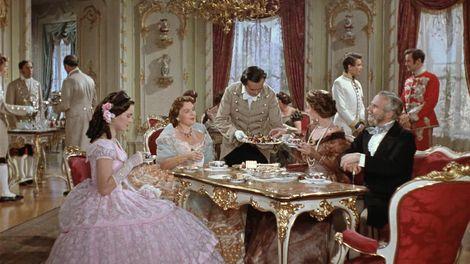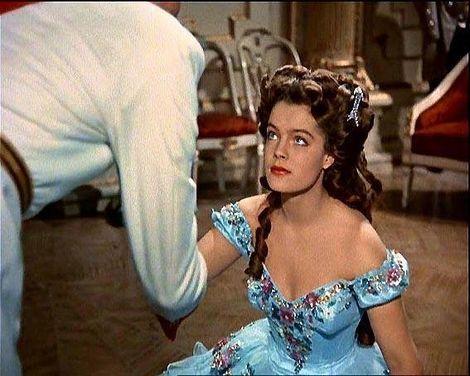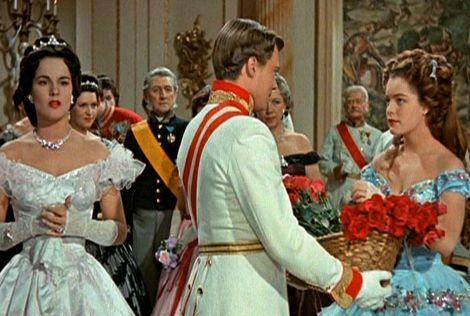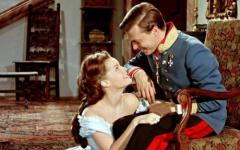THE COTILLION - "I think I was dancing with our future Empress"
Sissi Movies and the Reality
On the silver screen in the film Sissi (1955), Franz Joseph sends Count Grüne to the Ischl Villa (where his mother, his aunt, Lodovica and his cousin, Helene wait for him) instead of himself while he hunts in the forest with a girl who does not reveal her identity but she is Sissi herself. The reality was quite different from this scene: Elisabeth also attended the tea party with her mother and sister and the Emperor was waiting for them in time.
The tea and what came after that...
The reality: On the tea party, which was followed by a dinner, one of the Emperor’s brother, Karl Ludwig, who liked Sisi very much and had changed letters with her after they first meeting several years before, also took part in the event. According to Elisabeth’s bibliographer, Brigitte Hamann, Sisi was sitting with her governess at the end of the table, where she felt herself a bit uncomfortably because of being treated as a child. She might have had some idea about what was happening, however, Helene knew very well "what was at stake."
Sissi (1955) - Photo credit: Seven Stars Digital

On the tea party and the dinner after that many guests noticed that the Emperor was so fond of and delighted by the young Sisi. He liked Elisabeth’s weak and fine shape, gorgeous hair and the lovely expression of her face. When Sisi realises that he was looking at her, she lost all her consciousness and calmness. She was embarrassed and confused, which was realised by Karl Ludwig at once, who immediately noticed that his brother preferred his chosen one better and not her older sister. Sisi whispered her governess's, "I am so scared that I'm not hungry any more."
The Emperor had made his decision, however, Archduchess Sophie asked him not to rush the thing and consider it well, but his opinion was that one should not hesitate for long: The next morning, on 17 August 1853, Franz Joseph got up even more earlier than usual, and appeared happily at Sophia's suite, who soon wrote the following to her twin sister, Mary, the Queen of the Saxons: "My son told me with a delighted face that he found Sisi fascinating...”
THE BALL - in the evening before the Emperor’s birthday
The ballroom scene is a well-known one from the first part of the trilogy. The ball took place on 17 August, the evening before Franz Joseph's 23th birthday, not 18th like on the screen. Just like in the movie, at first, Sisi had not been invited to the party but it was not Sophie’s (in the film it was) but the Emperor’s request to invite Elisabeth to the ball. And, as mentioned, it was not the first time he met the Bavarian Duchess. One can vividly recall the scene when Sisi enters the ballroom wearing light blue prom dress with a glittering diamond arrow in her hair to the amazement of Franz. Helen - like on the screen- was wearing a beautiful white silk dress; however, Sisi’s dress was much more modest. The younger Bavarian Duchess was wearing a simple peach tulle (according to one of her bibliographer, Cars) or a rosy white muslin prom dress (according to another one, Count Corti), which was prepared not long before their departure from Possenhofen. However, the jewel was in her hair just like on the screen: those who attended the ball could see the glittering small diamond arrow which pushed back "the brown gold waves from her forehead" (Corti, 21).
Sissi (1955) - Photo credit: Seven Stars Digital

THE COTILLION - "I think I was dancing with our future Empress!"
The sentence quoted above is from Hugo von Weckbeckert, Franz Joseph’s adjutant, who was asked by Archduchess Sophie to dance with Sisi, who wanted to see how her niece danced. It was impossible to him not to notice that the Emperor was constantly looking at his dance partner. The shy Elisabeth tried to dance with the best of her ability. Then it was the time for the cotillion. Watching the film, one can see how confident the Emperor is when walking straight towards Sisi with all the bouquets of the red roses, which is thought to be against the etiquette since he should give a bouquet to every lady who he dances with. This effective scene was quite similar in the real life to the guests’ greatest astonishment. However, the Emperor handed only one bouquet to Sisi, who did not realise that it meant a wedding proposal. According to her bibliographer, Brigitte Hamann, when Elisabeth was asked whether she realised the Emperor's attention towards her, she simply said, "No. It only made me embarrassed”.
Everyone on the ball, without exception, knew what was happening and what it was about, that is, it was not Helen who would be the fiancée of Franz but her younger sister, Elisabeth. Sisi was embarrassed since everybody was staring at her but she did not know the etiquette very well so she did not realise what that all meant. She could hardly stand being highlighted and later as an empress it would not change...
Sissi (1955) - Photo credit: Seven Stars Digital

After handing the bouquet to Elisabeth, the Emperor was dancing with her. Sisi was embarrassed sometimes and forgot what steps followed but Franz whispered in her ear what to step. On the screen, as opposed to the reality, the young couple does not dance with each other but appears at the balcony of Schönbrunn Palace, where fireworks are seen on the occasion of the Emperor's birthday. In the historical reality, Franz officially presented his fiancée just after the next morning Mass.
The Next Day Carriage Ride
There is no scene in the film in connection with it but to have a clue about Helene’s fortitude the following is worth mentioning. Elisabeth was indisposed by the next day short carriage ride where Franz and his mother took her and Helene. The Emperor was wild with joy and kept looking at Sisi. According to Count Corti, the above mentioned bibliographer of Elisabeth, it was only Helene who was talking "a lot loudly and cheerfully, though, everyone had the feeling that everything she said seemed to be a bit depressed and artificial”.
To be continued... What is behind the fairy tale? Read the article here, or watch the video below!
Visit Empress Elisabeth on Facebook.
MAGYARUL: A COTILLION – Film és valóság
Works CitedHamann, Brigitte. The Reluctant Empress. A Biography of Empress Elisabeth of Austria. Ullstein, 2000Count Corti Egon: Erzsébet. Révai Kadás, Budapest, 1935Jean des Cars: Sisi avagy a végzet. Magyar Könyvklub, Budapest, 2001Soós István: Sisi és családja. Erzsébet, a magyarok királynéja. Rubicon, Budapest, 2001F. Dózsa Katalin: A világ legszebb asszonya. Erzsébet, a magyarok királynéja. Rubicon, Budapest, 2001



